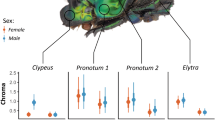Summary
Eggs of birds nesting in wet and dry habitats, have been artificially incubated at controlled humidity white weight loss of the eggs and shell water vapour conductance have been determined. Eggs of species from wet habitats loose weight at a higher rate than those from drier habitats at a given relative humidity.
It is suggested that the conductance of the egg shell to water vapour is adapted to the conditions of humidity in the environment such that weight loss varies little (and less than predictable) in relation to the relative humidity at the nesting sites.
The relative humidity surrounding eggs during natural incubation was found to be in the range of 30–50% in 4 different species. Humidity in the nest during natural incubation was found to be higher than what would result if ambient air was heated to incubation temperature indicating that the sitting bird conserves humidity around the eggs.
Similar content being viewed by others
References
Ar, A., Paganelli, C.V., Reeves, R.B., Greene, D.G., Rahn, H.: The avian egg: Water vapour conductance, shell thickness and functional pore area. Condor76, 153–158 (1974)
Barott, H.G.: Effect of temperature, humidity and other factors on hatch of hen's eggs and on energy metabolism of chick embryos. Techn. Bull. U.S. Dept. Agric. 553 (1937)
Boone, M.A., Barmore, C.R.: Weight loss in eggs during incubation. Poultry Sci.44, 1353 (1965)
Huggins, R.A.: Egg temperatures of wild birds under natural conditions. Ecology22, 148–157 (1941)
Koch, A., Steinke A.: Temperatur-und Feuchtigkeitsmessungen im Brutnest von Gänsen, Puten und Hühnern. Beitr. Fortpfl. Biol. Vögel20, 41–45 (1944)
Lundy, H. L.: A review of the effects of temperature humidity turning and gaseous environment in the incubator on the hatchability of the hen's egg. In The fertility and hatchability of the hen's egg (Carter, T. C. and Freeman., B. M. (eds.) Edinburgh Oliver and Boyd 1969
Rahn, H., Ar, A.: The avian egg: Incubation time and water loss. Condor76, 147–152 (1974)
Robertson, I.S.: Studies on the effect of humidity on the hatchability of hen's eggs. I. The determination of the optimum humidity for incubation. J. agric. Sci. (Cambridge)57, 185–194 (1961)
Romanoff, A.L.: Biochemistry and biophysics of the developing hen's egg. I. Influence of humidity. Mem. Cornell Univ. agric. Exp. Sta.132, 1–27 (1930)
Witherby, H.F.: The handbook of British birds. London (1943)
Author information
Authors and Affiliations
Rights and permissions
About this article
Cite this article
Lomholt, J.P. Relationship of weight loss to ambient humidity of birds eggs during incubation. J Comp Physiol B 105, 189–196 (1976). https://doi.org/10.1007/BF00691121
Received:
Issue Date:
DOI: https://doi.org/10.1007/BF00691121



